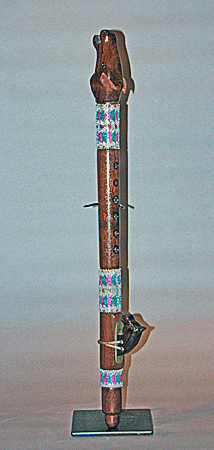
Owner: HWMC
Catalog#: NA-AEWF-03
Edge-blown Flutes
Winnebago 'Courting' Flute
Nebraska
Great Plains / Winnebago
Cherry Wood, beads
Mid-20th century
Length: 23 in
Aerophone – Wind Instrument Proper – Edge-blown Flutes
A signed ‘Winnebago’ (‘tsal-eet-quash-to’) plains flute or courting flute, used to woo or seek the favor of a young man’s sweetheart. The horse head carved at the end is a continuation of the sound chamber, all carved from one-piece of wood.
The Winnebago People’s ancestral lands were first in central Wisconsin and northern Illinois. Today they are located in Nebraska where the Winnebago Indian Reservation was established by treaties of 1865 and 1874. The Winnebago, also known as the ‘Ho-Chunk’ (Ho-Chąąnk), are a Siouan-speaking people (Hoocąk-language) who are located and enrolled in two federally recognized tribes, the Ho-Chunk Nation of Wisconsin and the Winnebago Tribe of Nebraska.
This Winnebago flute has two air chambers: The end that is closest to the player’s mouth with a slanted upward (ramp-type) channel, and the bottom foot end or sound chamber, also called the pipe body. Inside the flute is a plug or stopper that separates these two chambers. The Native American flute is not strictly considered an end-blown flute. Air is blown into the mouth hole of the flute and travels to the exit hole of the first chamber, on top, where there is an affixed external/mobile block (seen here is a horse head). This affixed block serves as a roof or cover at the ‘wind way’ between both chambers and directs the blown air into the flue of the second chamber across a splitting edge (fipple edge). This sound chamber with six fingerholes, allow the player to change the frequency (pitch) of the vibrating air by covering the holes with their fingers.
Reference: https://www.flutetree.com/nature/EarliestPlainsFlutes.html ; http://www.winnebagotribe.com/index.php/about-us/tribal-history
